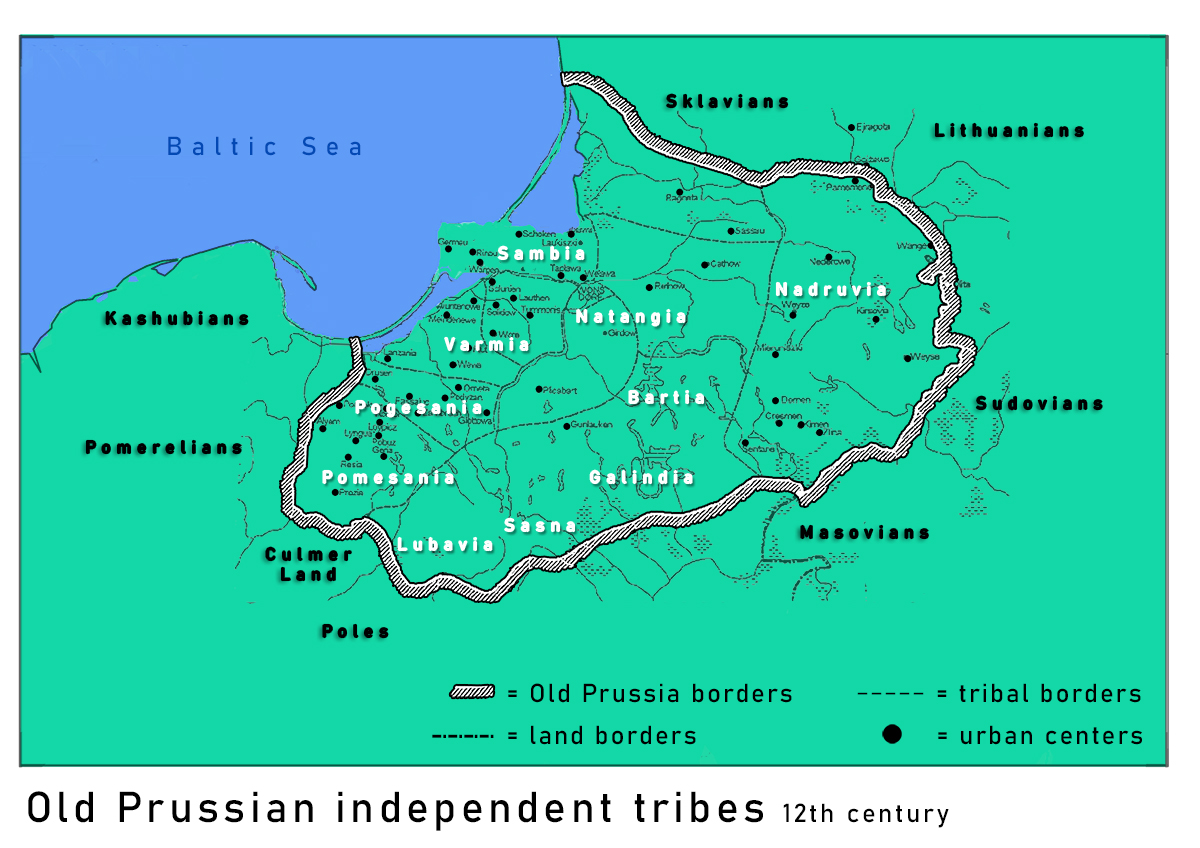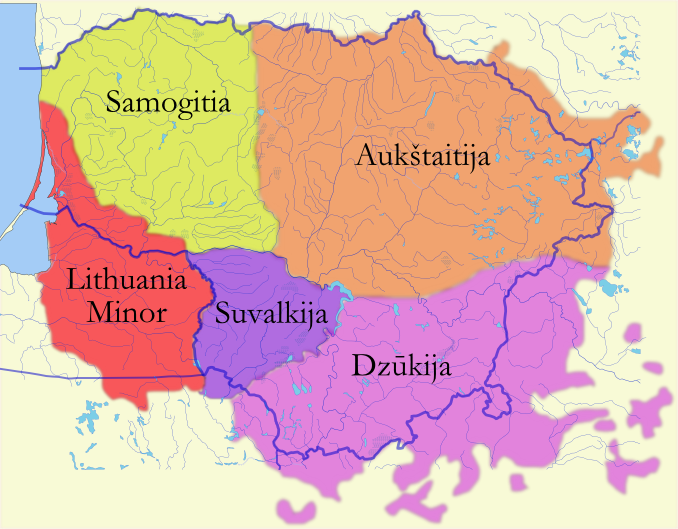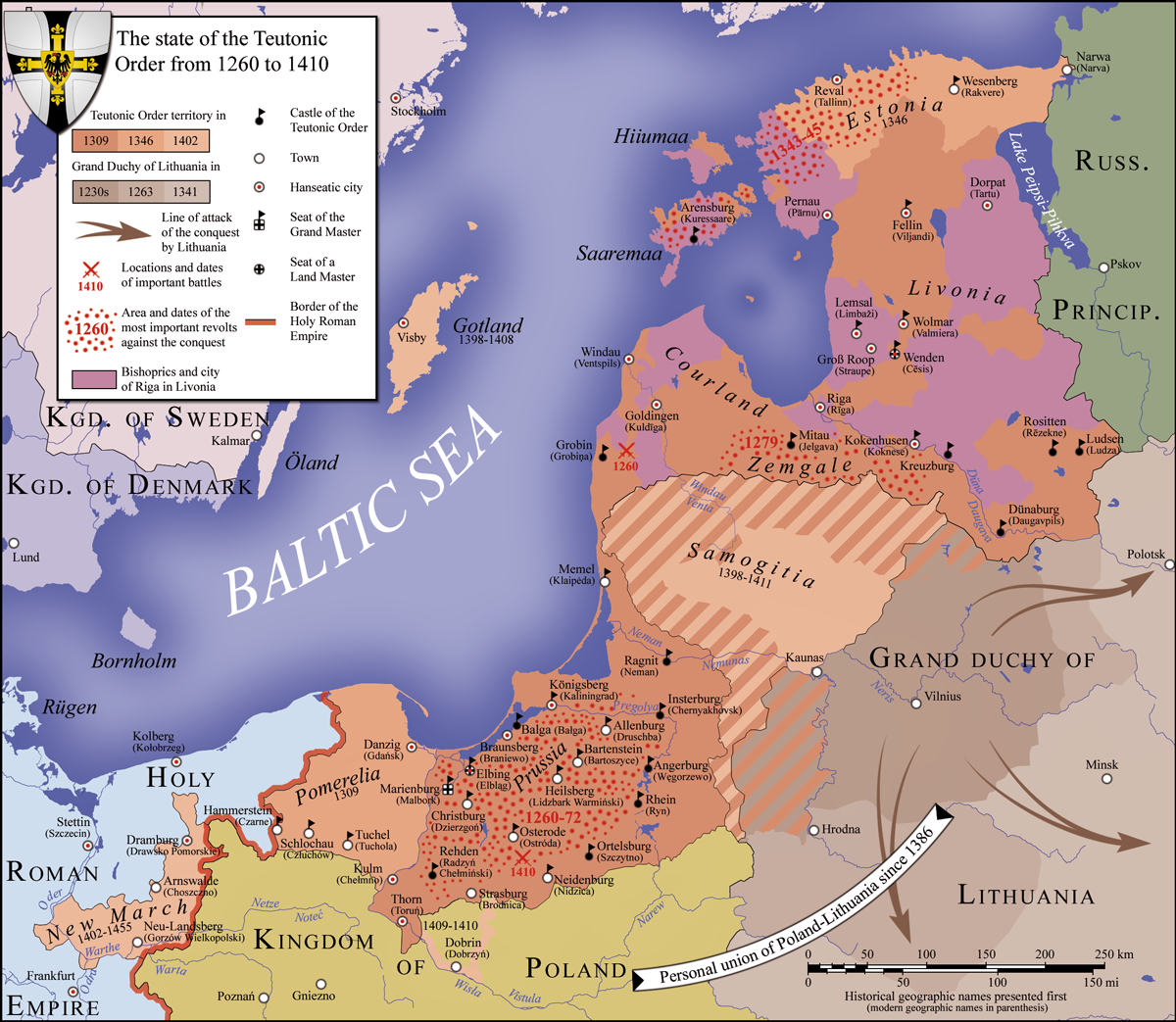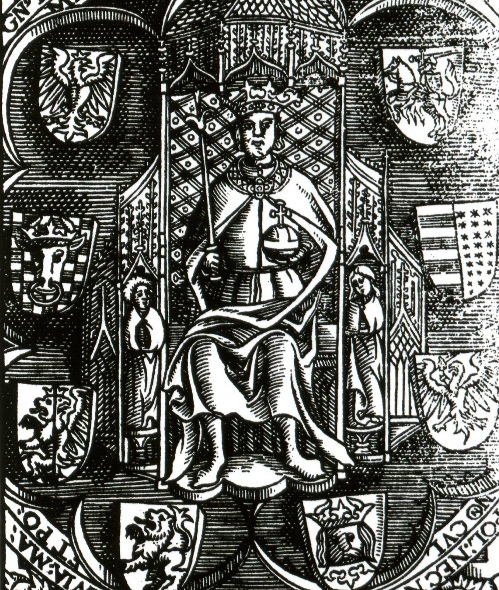|
Nadrovia
The Nadruvians were a now-extinct Prussian tribe. They lived in Nadruvia (alternative spellings include: ''Nadruva'', ''Nadrowite'', ''Nadrovia'', ''Nadrauen'', ''Nadravia'', ''Nadrow'' and ''Nadra''), a large territory in northernmost Prussia. They bordered the Skalvians on the Neman (Nemunas) River just to the north, the Sudovians to the east, and other Prussian tribes to the south and west. Most information about the clan is provided in a chronicle by Peter von Dusburg. History In 1236 Peter of Dusburg wrote that Nadruvia was the location of Romuva, the sacred center of Baltic religion. From Romuva Kriwe, the chief priest or "pagan Pope", ruled over the religion of all the Balts. No other sources mention the place. Scientists have considerable doubts if such an organized structure existed. As the northernmost clan, Nadruvians were conquered last by the Teutonic Knights, a German crusading military order. In 1230 the Knights set up their base in the Chełmno Land in Poland and ... [...More Info...] [...Related Items...] OR: [Wikipedia] [Google] [Baidu] |
Old Prussians
Old Prussians, Baltic Prussians or simply Prussians were a Balts, Baltic people that inhabited the Prussia (region), region of Prussia, on the southeastern shore of the Baltic Sea between the Vistula Lagoon to the west and the Curonian Lagoon to the east. As Balts, they spoke an Indo-European languages, Indo-European language of the Baltic languages, Baltic branch now known as Old Prussian language, Old Prussian and worshipped pre-Christian Prussian mythology, deities. Their ethnonym was later adopted by predominantly Low German language, Low German-speaking inhabitants of the region. The duchy of the Duchy of Poland (c. 960–1025), Polans under Mieszko I, which was the predecessor of the Kingdom of Poland (1025–1385), Kingdom of Poland, first attempted to conquer and baptize the Baltic tribes during the 10th century, but repeatedly encountered strong resistance. Not until the 13th century were the Old Prussians subjugated and their lands conquered by the State of the Teuton ... [...More Info...] [...Related Items...] OR: [Wikipedia] [Google] [Baidu] |
Prussia (region)
Prussia (; ; ; ; ; //) is a Historical regions of Central Europe, historical region in Central Europe on the south-eastern coast of the Baltic Sea, that ranges from the Vistula delta in the west to the end of the Curonian Spit in the east and extends inland as far as Masuria, divided between Poland (Warmian–Masurian Voivodeship), Russia (Kaliningrad Oblast) and Lithuania (Lithuania Minor). This region is often also referred to as Old Prussia. Tacitus's ''Germania (book), Germania'' (98 AD) is the oldest known record of an eyewitness account on the territory and its inhabitants. Pliny the Elder had already confirmed that the Romans had navigated into the waters beyond the ''Cimbric peninsula'' (Jutland). Swedes (Germanic tribe), Suiones, Sitones, Goths and other Germanic people had temporarily settled to the east and west of the Vistula River during the Migration Period, adjacent to the Aesti, who lived further to the east. Overview The region's inhabitants of the Middle ... [...More Info...] [...Related Items...] OR: [Wikipedia] [Google] [Baidu] |
Sambians
The Sambians were a Prussian tribe. They inhabited the Sambia Peninsula north of the city of Königsberg (now Kaliningrad). Sambians were located in a coastal territory rich in amber and engaged in trade early on (see Amber Road). Therefore, they established contacts with foreign nations before any other Prussians. However, as with all other Prussians, they were conquered by the Teutonic Knights, and, exposed to assimilation and Germanization, became extinct sometime in the 17th century. The Sambians bordered the Natangians in the south, and the Nadruvians in the east. History Engaged in the amber trade, Sambia was the richest and most densely populated region of Prussia. It provides a wealth of artifacts from the Bronze Age, including imported goods from the Roman Empire. Sambians, unlike other Prussians, did not cremate their dead. They built earth barrows above graves and surrounded them with stone circles. The name of the clan was first mentioned in 1073 by Adam of Bremen ... [...More Info...] [...Related Items...] OR: [Wikipedia] [Google] [Baidu] |
Lithuania Minor
Lithuania Minor (; ; ) or Prussian Lithuania (; ; ) is one of five ethnographic regions of Lithuania. It is a historical region of Prussia, where Prussian Lithuanians (or Lietuvininkai) lived, now located in Lithuania and the Kaliningrad Oblast of Russia. Lithuania Minor encompassed the northeastern part of the region and got its name from the territory's substantial Lithuanian-speaking population. Prior to the invasion of the Teutonic Knights in the 13th century, the main part of the territory later known as Lithuania Minor was inhabited by the tribes of Skalvians and Nadruvians. The land depopulated during the incessant war between Lithuania and the Teutonic Order. The war ended with the Treaty of Melno and the land was repopulated by Lithuanian newcomers, returning refugees, and the remaining indigenous Baltic peoples; the term Lithuania Minor appeared for the first time between 1517 and 1526. With the exception of the Klaipėda Region, which became a mandated territo ... [...More Info...] [...Related Items...] OR: [Wikipedia] [Google] [Baidu] |
Ducal Prussia
The Duchy of Prussia (, , ) or Ducal Prussia (; ) was a duchy in the region of Prussia established as a result of secularization of the Monastic Prussia, the territory that remained under the control of the State of the Teutonic Order until the Protestant Reformation in 1525. Overview The duchy became the first Protestant state when Albert, Duke of Prussia formally adopted Lutheranism in 1525. It was inhabited by a German, Polish (mainly in Masuria), and Lithuanian-speaking (mainly in Lithuania Minor) population. In 1525, during the Protestant Reformation, in accordance to the Treaty of Kraków, the Grand Master of the Teutonic Knights, Albert, secularized the order's prevailing Prussian territory (the Monastic Prussia), becoming Albert, Duke of Prussia. As the region had been a part of the Kingdom of Poland since the Second Peace of Thorn (1466), King of Poland Sigismund I the Old, as its suzerain, granted the territory as a hereditary fief of Poland to Duke Albert per ... [...More Info...] [...Related Items...] OR: [Wikipedia] [Google] [Baidu] |
Fief
A fief (; ) was a central element in medieval contracts based on feudal law. It consisted of a form of property holding or other rights granted by an overlord to a vassal, who held it in fealty or "in fee" in return for a form of feudal allegiance, services or payments. The fees were often lands, land revenue or revenue-producing real property like a watermill, held in feudal land tenure: these are typically known as fiefs or fiefdoms. However, not only land but anything of value could be held in fee, including governmental office, rights of exploitation such as hunting, fishing or felling trees, monopolies in trade, money rents and tax farms. There never existed a standard feudal system, nor did there exist only one type of fief. Over the ages, depending on the region, there was a broad variety of customs using the same basic legal principles in many variations. Terminology In ancient Rome, a " benefice" (from the Latin noun , meaning "benefit") was a gift of land () f ... [...More Info...] [...Related Items...] OR: [Wikipedia] [Google] [Baidu] |
Thirteen Years' War (1454–1466)
The Thirteen Years' War (; ), also called the War of the Cities, was a conflict fought in 1454–1466 between the Crown of the Kingdom of Poland and the Teutonic Order. After the Battle of Grunwald, enormous defeat suffered by the German Order at the hand of Poland-Lithuania in 1410 and the ensuing political, military and economic problems, the state was rife with internal conflict between the ruling Order and the Old Prussians, native Prussian warlords, who shared concerns with assimilated Prussian and German townsfolk. Eventually this tension led to an uprising by the Prussian Confederation representing the local Prussian nobility and cities, who sought the protection of the Polish King Casimir IV Jagiellon. This essentially amounted to a switching of sides which the German Order immediately took as a mortal threat, and a war broke out between Poland and the Teutons. The Thirteen Years' War ended in the victory of Poland and in the Second Peace of Thorn (1466), Second Peace ... [...More Info...] [...Related Items...] OR: [Wikipedia] [Google] [Baidu] |
Crown Of The Kingdom Of Poland
The Crown of the Kingdom of Poland (; ) was a political and legal concept formed in the 14th century in the Kingdom of Poland, assuming unity, indivisibility and continuity of the state. Under this idea, the state was no longer seen as the Patrimonialism, patrimonial property of the monarch or dynasty, but became a common good of the political community of the kingdom. This notion allowed the state to maintain stability even during periods of interregnum and paved the way for a unique political system in Poland, characterized by a noble-based parliament and the Free election (Poland), free election of the monarch. Additionally, the concept of the Crown extended beyond existing borders, asserting that previously lost territories still rightfully belonged to it. The term ''Crown of the Kingdom of Poland'' also referred to all the lands under the rule of the Polish king. This meaning became especially significant after the Union of Lublin, union with the Grand Duchy of Lithuania, w ... [...More Info...] [...Related Items...] OR: [Wikipedia] [Google] [Baidu] |
Casimir IV Jagiellon
Casimir IV (Casimir Andrew Jagiellon; ; Lithuanian: ; 30 November 1427 – 7 June 1492) was Grand Duke of Lithuania from 1440 and King of Poland from 1447 until his death in 1492. He was one of the most active Polish-Lithuanian rulers; under him, Poland defeated the Teutonic Knights in the Thirteen Years' War and recovered Pomerania. The Jagiellonian dynasty became one of the leading royal houses in Europe. The great triumph of his reign was bringing Prussia under Polish rule. The rule of Casimir corresponded to the age of "new monarchies" in western Europe. By the 15th century, Poland had narrowed the distance separating it from Western Europe and became a significant power in international relations. The demand for raw materials and semi-finished goods stimulated trade, producing a positive balance, and contributed to the growth of crafts and mining in the entire country. He was a recipient of the English Order of the Garter (KG), the highest order of chivalry and the most ... [...More Info...] [...Related Items...] OR: [Wikipedia] [Google] [Baidu] |
Germans
Germans (, ) are the natives or inhabitants of Germany, or sometimes more broadly any people who are of German descent or native speakers of the German language. The Basic Law for the Federal Republic of Germany, constitution of Germany, implemented in 1949 following the end of World War II, defines a German as a German nationality law, German citizen. During the 19th and much of the 20th century, discussions on German identity were dominated by concepts of a common language, culture, descent, and history.. "German identity developed through a long historical process that led, in the late 19th and early 20th centuries, to the definition of the German nation as both a community of descent (Volksgemeinschaft) and shared culture and experience. Today, the German language is the primary though not exclusive criterion of German identity." Today, the German language is widely seen as the primary, though not exclusive, criterion of German identity. Estimates on the total number of Germ ... [...More Info...] [...Related Items...] OR: [Wikipedia] [Google] [Baidu] |
Lithuanians
Lithuanians () are a Balts, Baltic ethnic group. They are native to Lithuania, where they number around 2,378,118 people. Another two million make up the Lithuanian diaspora, largely found in countries such as the Lithuanian Americans, United States, Lithuanians in the United Kingdom, United Kingdom, Lithuanian Brazilians, Brazil and Lithuanian Canadians, Canada. Their native language is Lithuanian language, Lithuanian, one of only two surviving members of the Baltic language family along with Latvian language, Latvian. According to the Lithuanian census of 2021, census conducted in 2021, 84.6% of the population of Lithuania identified themselves as Lithuanians. Most Lithuanians belong to the Catholic Church in Lithuania, Catholic Church, while the Lietuvininkai who lived in the northern part of East Prussia prior to World War II, were mostly Lutherans. History The territory of the Balts, including modern Lithuania, was once inhabited by several Baltic tribal entities (Sudovi ... [...More Info...] [...Related Items...] OR: [Wikipedia] [Google] [Baidu] |
Monastic State Of The Teutonic Knights
The State of the Teutonic Order () was a theocratic state located along the southeastern shore of the Baltic Sea in northern Europe. It was formed by the knights of the Teutonic Order during the early 13th century Northern Crusades in the region of Prussia. In 1237, the Livonian Brothers of the Sword merged with the Teutonic Order of Prussia and became known as its branch – the Livonian Order (while their state, ''Terra Mariana'', covering present-day Estonia, Latvia, and a small part of Russia, became part of the State of the Teutonic Order). At its greatest territorial extent during the early 15th century, the State encompassed Chełmno Land, Courland, Gotland, Livonia, Estonia, Neumark, Pomerelia ( Gdańsk Pomerania), Prussia and Samogitia. Following the battles of Grunwald in 1410 and Wilkomierz in 1435, the State fell into decline. After losing extensive territories in the imposed Peace of Thorn in 1466, the extant territory of its Prussian branch became known as ... [...More Info...] [...Related Items...] OR: [Wikipedia] [Google] [Baidu] |






